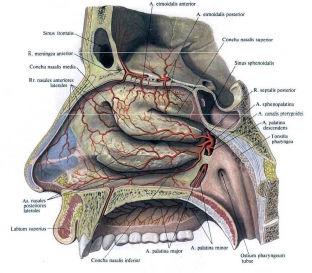The human nose is a truly amazing invention of nature. The nose is one of the organs of the respiratory system, as well as a sense organ. When we meet a new person, we pay attention, first of all, to his face. The eyes, lips, and nose are areas of the human face that help determine how attractive a person is to us. The laying of the human nose occurs in the first weeks of embryogenesis, and already with ultrasound during pregnancy, you can see the nose of the unborn child. The anatomy of the human nose is quite complex, as there are a large number of important functions of the nose. Estet-portal.com offers you a brief guide to the structure and functional features of the human nose.
Human external nose: anatomical structure
The external nose (nasus externus) is the initial part of the human respiratory system. The region of the nose on the face is called the region nasalis and in its shape the human nose resembles a pyramid. In the external nose, the following parts are distinguished: the back of the nose (dorsum nasi), the root of the nose (radix nasi), the tip of the nose (apex nasi) and the wings of the nose (alae nasi). The back of the human nose is formed by the nasal bones, lateral cartilage and cartilage of the nasal septum, and the wings of the human nose – large and small cartilages of the wings. The large cartilage of the wing of the nose is paired and surrounds the entrance to the nasal cavity in front, from the sides and from the inside, thus forming the nostrils (nares). The cartilages of the human nose are covered with the perichondrium and are connected to each other and to adjacent tissues by fibrous tissue.
Human nasal cavity: structural features
The nasal cavity is called cavitas nasi and is divided by the nasal septum (septum nasi) into two almost symmetrical parts. In the septum of the human nose, a membranous part (pars membranacea), a cartilaginous part (pars cartilagines), and a bone part (pars ossea) are distinguished. The base of the nasal septum, which separates the nostrils, is called the movable part of the nasal septum (pars mobilis septi nasi). In the human nasal cavity itself, two parts are distinguished: the vestibule of the nasal cavity (vesibulum nasi), covered with skin, and the nasal cavity itself (cavitas nasi), lined with mucous membranes. The human nasal cavity is divided into paired nasal passages: upper, middle, lower and common nasal passage. The bones surrounding the nasal cavity are airy and contain the paranasal sinuses (sinus paranasales), which communicate with the nasal passages.
The mucous membrane of the human nasal cavity and sinuses is covered with hairs that trap microorganisms and small particles found in the inhaled air. In the mucous membrane of the human nose itself, there are mucous glands, the number and size of which depend on the area of the human nasal cavity. Most of the nasal glands are located in the mucous membrane of the respiratory region of the human nose. The mucous membrane of the nasal cavity is divided into the respiratory and olfactory regions. The olfactory region (regio olfactoria) occupies part of the human nasal mucosa, which lines the upper conchas and the free sides of the middle conchas, as well as the upper part of the nasal septum. It contains the endings of the olfactory nerves, due to which the olfactory function of the nose is performed.
The functions of the human nose: why do we need this organ
The human nose performs a large number of important functions that the body needs for normal functioning. The main function of the nose is a protective function. The hair in the nose, as well as the mucus produced by the glands of the nasal mucosa, allow bacteria and dust particles contained in the inhaled air to be trapped in the nose. Sneezing – This is a reflex that is realized when the mucous membrane of the human nose is irritated, and allows you to clear its cavity of irritants. In addition, the protective function of the human nose is also realized due to the ability of the nose to moisten and warm the inhaled air. The olfactory function of the nose lies in the ability of a person to capture and distinguish odors, which helps to better navigate in space, and also plays a role in triggering the release of saliva. The resonant function of the nose lies in its effect on the voice of a person, which changes with a runny nose, for example. Do not forget about such an important function of the nose as aesthetic. Every day, people come to see plastic surgeons with a request to modify their nose. Such operations can be treated differently, but, be that as it may, scientists have already proven that people who are satisfied with their own appearance achieve great success in life. And just one small operation to correct the shape of the nose can radically change a person's life!
scientists have already proven that people who are satisfied with their own appearance achieve great success in life. And just one small operation to correct the shape of the nose can radically change a person's life!scientists have already proven that people who are satisfied with their own appearance achieve great success in life. And just one small operation to correct the shape of the nose can radically change a person's life!








Add a comment